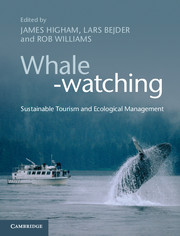Book contents
- Frontmatter
- Dedication
- Contents
- Acknowledgements
- List of contributors
- List of abbreviations
- 1 Tourism, cetaceans and sustainable development
- Part I The historical and contemporary contexts
- Part II Human dimensions of whale-watching
- Part III Ecological dimensions of whale-watching
- Part IV Sustainable management: insights and issues
- 18 The socioeconomic, educational and legal aspects of whale-watching
- 19 Vigilance, resilience and failures of science and management
- 20 Insights from agent-based modelling to simulate whale-watching tours
- 21 Cetacean-watching in developing countries
- 22 Kaikoura (New Zealand)
- 23 Management of dusky dolphin tourism at bKaikoura, New Zealand
- 24 Save the whales Part II
- 25 Time to rethink
- Index
- Plate Section
- References
22 - Kaikoura (New Zealand)
The concurrence of Māori values, governance and economic need
from Part IV - Sustainable management: insights and issues
Published online by Cambridge University Press: 05 April 2014
- Frontmatter
- Dedication
- Contents
- Acknowledgements
- List of contributors
- List of abbreviations
- 1 Tourism, cetaceans and sustainable development
- Part I The historical and contemporary contexts
- Part II Human dimensions of whale-watching
- Part III Ecological dimensions of whale-watching
- Part IV Sustainable management: insights and issues
- 18 The socioeconomic, educational and legal aspects of whale-watching
- 19 Vigilance, resilience and failures of science and management
- 20 Insights from agent-based modelling to simulate whale-watching tours
- 21 Cetacean-watching in developing countries
- 22 Kaikoura (New Zealand)
- 23 Management of dusky dolphin tourism at bKaikoura, New Zealand
- 24 Save the whales Part II
- 25 Time to rethink
- Index
- Plate Section
- References
Summary
Introduction
This chapter traces the history of human settlement in Kaikoura, focusing in particular on its origins as an important centre of Māori settlement (c. 950–1130 ad) and livelihood, subsequent European settlement (from the 1830s ad) to a world-class tourism destination based on whale-watching. Historical patterns of settlement, (indigenous) Māori–Pakeha (settler) relations, the early use of whales for commercial trade, subsequent periods of resource extraction and agricultural cycles of growth and decline establish the historical context of tourism development. Contemporary tourism development is, however, primarily based on desperate local economic conditions brought about by restructuring of the New Zealand economy in the mid-1980s.
The history of Kaikoura as a whale-watching destination must first be explored by examining its evolution within a larger set of Māori values. For Kaikoura these are centred around key concepts of:
mother earth (papatuanuku);
Mauri (the physical life force that imbues all living things) and
kaitiakitanga (guardianship of natural resources).
Although these are argued to be particularly poignant in Kaikoura where the (Ngai Tahu) Māori owned-and-operated Whalewatch Kaikoura has become the cornerstone tourist experience, elsewhere in New Zealand they have provided a unique context for resource management. Thus Māori values, alongside more recent resource exploitations, subsequent ‘boom and bust’ economic cycles and finally significant ‘restructuring’ of the late 1980s have paved the way for a cautious approach to contemporary tourism management based on scientific research and destination benchmarking and certification. The early adoption of the GreenGlobe21/earthcheck™ certification system, and Kaikoura's claim as the world's first independently certified tourism destination, have engendered sufficient momentum to see this approach to sustainability permeate all the District's activities and many of its productive sectors. This pathway, in turn, is argued to have arisen out of the unique concurrence of Māori values, tourism focused on marine mega-fauna, and a set of scientific partnerships that have been able to integrate and support a strong focus on governance and management for sustainability.
- Type
- Chapter
- Information
- Whale-watchingSustainable Tourism and Ecological Management, pp. 323 - 336Publisher: Cambridge University PressPrint publication year: 2014
References
- 2
- Cited by



